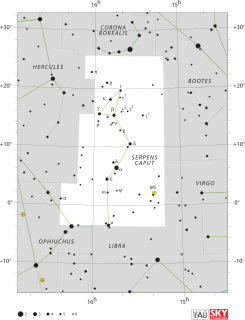
Serpens is a constellation of the northern hemisphere. One of the 48 constellations listed by the 2nd-century astronomer Ptolemy, it remains one of the 88 modern constellations defined by the International Astronomical Union. It is unique among the modern constellations in being split into two non-contiguous parts, Serpens Caput to the west and Serpens Cauda to the east. Between these two halves lies the constellation of Ophiuchus, the "Serpent-Bearer". In figurative representations, the body of the serpent is represented as passing behind Ophiuchus between Mu Serpentis in Serpens Caput and Nu Serpentis in Serpens Cauda.
Star formation is the process by which dense regions within molecular clouds in interstellar space, sometimes referred to as "stellar nurseries" or "star-forming regions", collapse and form stars. As a branch of astronomy, star formation includes the study of the interstellar medium (ISM) and giant molecular clouds (GMC) as precursors to the star formation process, and the study of protostars and young stellar objects as its immediate products. It is closely related to planet formation, another branch of astronomy. Star formation theory, as well as accounting for the formation of a single star, must also account for the statistics of binary stars and the initial mass function. Most stars do not form in isolation but as part of a group of stars referred as star clusters or stellar associations.

The Rosette Nebula is an H II region located near one end of a giant molecular cloud in the Monoceros region of the Milky Way Galaxy. The open cluster NGC 2244 is closely associated with the nebulosity, the stars of the cluster having been formed from the nebula's matter.
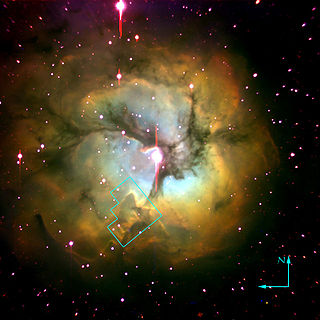
The Trifid Nebula is an H II region in the north-west of Sagittarius in a star-forming region in the Milky Way's Scutum-Centaurus Arm. It was discovered by Charles Messier on June 5, 1764. Its name means 'three-lobe'. The object is an unusual combination of an open cluster of stars, an emission nebula, a reflection nebula, and a dark nebula. Viewed through a small telescope, the Trifid Nebula is a bright and peculiar object, and is thus a perennial favorite of amateur astronomers.
Chi Boötis, Latinized as χ Boötis, is a single, white-hued star in the northern constellation Boötes, near the eastern constellation border with Corona Borealis. It is faintly visible to the naked eye with an apparent visual magnitude of +5.3. Based upon an annual parallax shift of 13.0 mas as seen from the Earth, it is located about 251 light years from the Sun. The star is moving closer to the Sun with a radial velocity of −16 km/s.

The Flame Nebula, designated as NGC 2024 and Sh2-277, is an emission nebula in the constellation Orion. It is about 900 to 1,500 light-years away.

The Serpens South star cluster is a relatively dense group of more than 600 young stars, dozens of which are protostars just beginning to form. The cluster is situated in the southern portion of the Serpens cloud. The stars are embedded in a dense filament of interstellar gas, which is part of the giant molecular cloud that has given rise to the cluster of young stars in W40. This entire complex is located at a distance of 1420 light-years from the Earth, and is approximately the same distance as the Serpens Main cluster.

HD 15115 is a single star in the equatorial constellation of Cetus. It is readily visible in binoculars or a small telescope, but is considered too dim to be seen with the naked eye at an apparent visual magnitude of 6.76. The distance to this object is 160 light years based on parallax, and it is slowly drifting further away at the rate of about 1 km/s. It has been proposed as a member of the Beta Pictoris moving group or the Tucana-Horologium association of co-moving stars; there is some ambiguity as to its true membership.
AFGL 2591 is a star forming region in the constellation Cygnus. Its dense cloud of gas and dust make its interior invisible to optical telescopes. Images in the infrared show a bright young stellar object, with an associated reflection nebula seen as a glowing cone projecting from the young star. A cluster of stars is forming within the molecular cloud, but most of the infrared radiation is coming from this star, AFGL 2591-VLA3.

NGC 1893 is an open cluster in the constellation Auriga. It is about 12,400 light years away. The star cluster is embedded in the HII region IC 410.
YZ Canis Minoris is a red-hued star in the equatorial constellation of Canis Minor. With an apparent visual magnitude of 11.15, it is much too faint to be viewed with the naked eye. The distance to YZ CMi can be estimated from its annual parallax shift of 167.02 mas, yielding a value of 19.5 light years. Presently the star is moving further away with a heliocentric radial velocity of +26.5 km/s. It made its closest approach some 162,000 years ago when it made perihelion passage at a distance of 10.2 ly. YZ CMi is a potential member of the Beta Pictoris moving group.

DR 21 is a large molecular cloud located in the constellation Cygnus, discovered in 1966 as a radio continuum source by Downes and Rinehart. DR 21 is located about 6,000 light-years (1,800 pc) from Earth and extends for 80 light-years (25 pc). The region contains a high rate of star formation and is associated with the Cygnus X star forming region. It has an estimated mass of 1,000,000 M☉.
Kepler-65 is a subgiant star slightly more massive than the Sun and has at least four planets.

Kepler-25 is a star in the northern constellation of Lyra. It is slightly larger and more massive than the sun with a luminosity 2½ times that of the sun. With an apparent visual magnitude of 10.6, this star is too faint to be seen with the naked eye.
7 Persei is a star in the constellation Perseus, located 774 light years away from the Sun. While the star bears the Bayer designation Chi Persei, it is not to be confused with the entire cluster NGC 884, commonly referred to as Chi Persei. It is faintly visible to the naked eye as a dim, yellow-hued star with an apparent visual magnitude of 5.99. This object is moving closer to the Earth with a heliocentric radial velocity of −12.5 km/s.

Westerhout 40 or W40 is a star-forming region in the Milky Way located in the constellation Serpens. In this region, interstellar gas forming a diffuse nebula surrounds a cluster of several hundred new-born stars. The distance to W40 is 436 ± 9 pc, making it one of the closest sites of formation of high-mass O-type and B-type stars. The ionizing radiation from the massive OB stars has created an H II region, which has an hour-glass morphology.
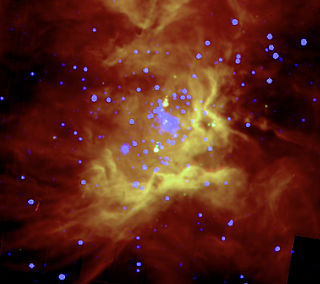
RCW 36 is an emission nebula containing an open cluster in the constellation Vela. This H II region is part of a larger-scale star-forming complex known as the Vela Molecular Ridge (VMR), a collection of molecular clouds in the Milky Way that contain multiple sites of ongoing star-formation activity. The VMR is made up of several distinct clouds, and RCW 36 is embedded in the VMR Cloud C.
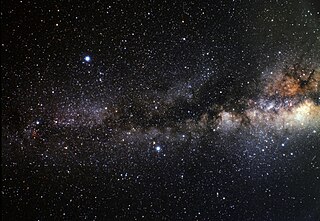
The Serpens-Aquila Rift (also known as the Aquila Rift) is a region of the sky in the constellations Aquila, Serpens Cauda, and eastern Ophiuchus containing dark interstellar clouds. The region forms part of the Great Rift, the nearby dark cloud of cosmic dust that obscures the middle of the galactic plane of the Milky Way, looking inwards and towards its other radial sectors. The clouds that form this structure are called "molecular clouds", constituting a phase of the interstellar medium which is cold and dense enough for molecules to form, particularly molecular hydrogen (H2). These clouds are opaque to light in the optical part of the spectrum due to the presence of interstellar dust grains mixed with the gaseous component of the clouds. Therefore, the clouds in the Serpens-Aquila Rift block light from background stars in the disk of the Galaxy, forming the dark rift. The complex is located in a direction towards the inner Galaxy, where molecular clouds are common, so it is possible that not all components of the rift are at the same distance and physically associated with each other.
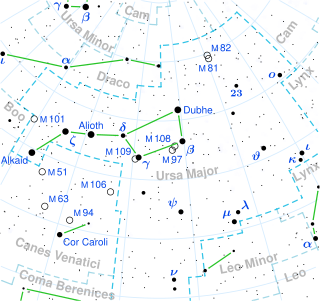
15 Leonis Minoris is the Flamsteed designation for a single star in the northern circumpolar constellation of Ursa Major. It has an apparent visual magnitude of 5.08, making it a fifth magnitude star that is visible to the naked eye. Based on parallax measurements, it is located at a distance of 61.7 light years from the Sun. The star has been examined for an infrared excess, but none was detected.
HD 168009 is a star in the northern constellation of Lyra. It has an apparent visual magnitude of 6.3, placing it just below the normal limit of stars visible to the naked eye under good viewing conditions. An annual parallax shift of 42.93 mas provides a distance estimate of 76 light years. It is moving closer to the Sun with a heliocentric radial velocity of −65 km/s. In about 328,000 years from now, the star will make its closest approach at a distance of around 17 ly (5.1 pc).













